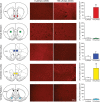Deep brain stimulation of the nucleus accumbens shell attenuates cocaine reinstatement through local and antidromic activation
- PMID: 24005296
- PMCID: PMC3761051
- DOI: 10.1523/JNEUROSCI.4804-12.2013
Deep brain stimulation of the nucleus accumbens shell attenuates cocaine reinstatement through local and antidromic activation
Abstract
Accumbal deep brain stimulation (DBS) is a promising therapeutic modality for the treatment of addiction. Here, we demonstrate that DBS in the nucleus accumbens shell, but not the core, attenuates cocaine priming-induced reinstatement of drug seeking, an animal model of relapse, in male Sprague Dawley rats. Next, we compared DBS of the shell with pharmacological inactivation. Results indicated that inactivation using reagents that influenced (lidocaine) or spared (GABA receptor agonists) fibers of passage blocked cocaine reinstatement when administered into the core but not the shell. It seems unlikely, therefore, that intrashell DBS influences cocaine reinstatement by inactivating this nucleus or the fibers coursing through it. To examine potential circuit-wide changes, c-Fos immunohistochemistry was used to examine neuronal activation following DBS of the nucleus accumbens shell. Intrashell DBS increased c-Fos induction at the site of stimulation as well as in the infralimbic cortex, but had no effect on the dorsal striatum, prelimbic cortex, or ventral pallidum. Recent evidence indicates that accumbens DBS antidromically stimulates axon terminals, which ultimately activates GABAergic interneurons in cortical areas that send afferents to the shell. To test this hypothesis, GABA receptor agonists (baclofen/muscimol) were microinjected into the anterior cingulate, and prelimbic or infralimbic cortices before cocaine reinstatement. Pharmacological inactivation of all three medial prefrontal cortical subregions attenuated the reinstatement of cocaine seeking. These results are consistent with DBS of the accumbens shell attenuating cocaine reinstatement via local activation and/or activation of GABAergic interneurons in the medial prefrontal cortex via antidromic stimulation of cortico-accumbal afferents.
Figures




Similar articles
-
Deep brain stimulation of the infralimbic cortex attenuates cocaine priming-induced reinstatement of drug seeking.Brain Res. 2020 Nov 1;1746:147011. doi: 10.1016/j.brainres.2020.147011. Epub 2020 Jul 8. Brain Res. 2020. PMID: 32652146 Free PMC article.
-
Deep brain stimulation of the nucleus accumbens shell attenuates cue-induced reinstatement of both cocaine and sucrose seeking in rats.Behav Brain Res. 2015 Mar 15;281:125-30. doi: 10.1016/j.bbr.2014.12.025. Epub 2014 Dec 18. Behav Brain Res. 2015. PMID: 25529183 Free PMC article.
-
Deep brain stimulation of the nucleus accumbens shell attenuates cocaine priming-induced reinstatement of drug seeking in rats.J Neurosci. 2008 Aug 27;28(35):8735-9. doi: 10.1523/JNEUROSCI.5277-07.2008. J Neurosci. 2008. PMID: 18753374 Free PMC article.
-
Attenuation of cocaine seeking in rats via enhancement of infralimbic cortical activity using stable step-function opsins.Psychopharmacology (Berl). 2019 Jan;236(1):479-490. doi: 10.1007/s00213-018-4964-y. Epub 2018 Jul 12. Psychopharmacology (Berl). 2019. PMID: 30003306 Free PMC article. Review.
-
Deep brain stimulation for the treatment of addiction: basic and clinical studies and potential mechanisms of action.Psychopharmacology (Berl). 2013 Oct;229(3):487-91. doi: 10.1007/s00213-013-3214-6. Epub 2013 Aug 2. Psychopharmacology (Berl). 2013. PMID: 23907650 Free PMC article. Review.
Cited by
-
Deep brain stimulation for psychostimulant use disorders.J Neural Transm (Vienna). 2024 May;131(5):469-473. doi: 10.1007/s00702-023-02706-6. Epub 2023 Oct 12. J Neural Transm (Vienna). 2024. PMID: 37823965 Review.
-
Deep brain stimulation for substance use disorder: a systematic review and meta-analysis.Front Psychiatry. 2023 Aug 10;14:1231760. doi: 10.3389/fpsyt.2023.1231760. eCollection 2023. Front Psychiatry. 2023. PMID: 37636824 Free PMC article. Review.
-
Going and stopping: Dichotomies in behavioral control by the prefrontal cortex.Nat Neurosci. 2016 Apr 26;19(6):656-664. doi: 10.1038/nn.4275. Nat Neurosci. 2016. PMID: 29162973 Free PMC article.
-
Bidirectional Modulation of Extinction of Drug Seeking by Deep Brain Stimulation of the Ventral Striatum.Biol Psychiatry. 2016 Nov 1;80(9):682-690. doi: 10.1016/j.biopsych.2016.05.015. Epub 2016 May 27. Biol Psychiatry. 2016. PMID: 27449798 Free PMC article.
-
Is Deep Brain Stimulation an Effective Treatment for Psychostimulant Dependency? A Preclinical and Clinical Systematic Review.Neurochem Res. 2023 May;48(5):1255-1268. doi: 10.1007/s11064-022-03818-3. Epub 2022 Nov 29. Neurochem Res. 2023. PMID: 36445490
References
-
- Anderson SM, Schmidt HD, Pierce RC. Administration of the D2 dopamine receptor antagonist sulpiride into the shell, but not the core, of the nucleus accumbens attenuates cocaine priming-induced reinstatement of drug seeking. Neuropsychopharmacology. 2006;31:1452–1461. doi: 10.1038/sj.npp.1300922. - DOI - PubMed
-
- Anderson SM, Bari AA, Pierce RC. Administration of the D1-like dopamine receptor antagonist SCH-23390 into the medial nucleus accumbens shell attenuates cocaine priming-induced reinstatement of drug-seeking behavior in rats. Psychopharmacology (Berl) 2003;168:132–138. doi: 10.1007/s00213-002-1298-5. - DOI - PubMed
-
- Benazzouz A, Hallett M. Mechanism of action of deep brain stimulation. Neurology. 2000;55(12 Suppl 6):S13–S16. - PubMed
Publication types
MeSH terms
Substances
Grants and funding
LinkOut - more resources
Full Text Sources
Other Literature Sources
